Introduction : Pourquoi la poudre sphérique change la donne dans la fabrication moderne
Imaginez que vous essayez de remplir un bocal avec des billes et des cailloux. Les billes, lisses et uniformes, se mettent en place sans effort, en laissant un minimum d'espace. Imaginez maintenant que vous fassiez la même chose avec des cailloux de forme irrégulière. Vous auriez du mal à les tasser, n'est-ce pas ? C'est le principe qui sous-tend Poudre sphérique-Des particules minuscules et uniformes qui s'écoulent et se tassent efficacement, révolutionnant les industries de l'aérospatiale à l'ingénierie biomédicale.
Dans cet article, nous allons nous plonger dans le monde de la poudre sphérique. Nous explorerons les différents types de poudre sphérique, nous nous pencherons sur ses propriétés uniques et nous expliquerons pourquoi il s'agit d'un matériau de choix pour la fabrication de haute précision. Nous comparerons également différents modèles, décrirons leurs utilisations spécifiques et vous guiderons à travers les avantages et les inconvénients de chacun d'entre eux. Que vous soyez un ingénieur chevronné ou un simple curieux des matériaux de pointe, ce guide a quelque chose à vous offrir.
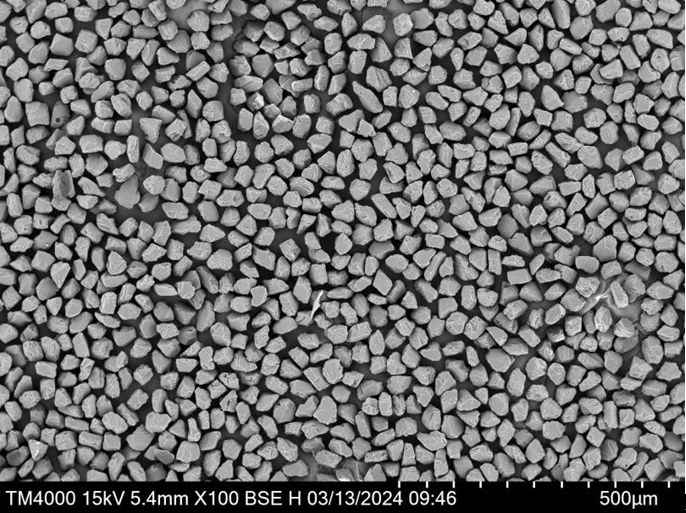
Aperçu de la poudre sphérique
Qu'est-ce que la poudre sphérique ?
La poudre sphérique se compose de particules fines et rondes qui sont généralement créées à l'aide de procédés tels que l'atomisation. Ces poudres sont très recherchées en raison de leur fluidité et de leur densité supérieures à celles des particules de forme irrégulière. Qu'il s'agisse de métaux, de céramiques ou de polymères, les poudres sphériques sont plus faciles à travailler.
L'importance de la forme
La forme sphérique n'est pas seulement esthétique. C'est la clé pour obtenir des revêtements uniformes, une précision dans la fabrication additive et même une uniformité dans des produits tels que les produits pharmaceutiques. En matière de fabrication, l'uniformité et la prévisibilité sont essentielles. Imaginez que vous fassiez cuire un gâteau avec des ingrédients de formes et de tailles différentes : certaines parties cuiraient plus vite, d'autres plus lentement, ce qui donnerait un résultat inégal. La poudre sphérique garantit que chaque ‘ingrédient’ ; est uniforme, ce qui permet d'obtenir un produit final de qualité supérieure.
Composition de la poudre sphérique
Types de poudre sphérique et leurs compositions
Les différentes industries ont besoin de différents types de poudres sphériques, chacune ayant une composition unique adaptée à des applications spécifiques. Voici un examen plus approfondi de quelques-uns des types les plus courants :
| Type de poudre sphérique | Composition primaire | Caractéristiques | Applications |
|---|---|---|---|
| Poudre sphérique de titane | Titane (Ti) | Haute résistance, légèreté, résistance à la corrosion | Aérospatiale, implants biomédicaux |
| Poudre sphérique d'aluminium | Aluminium (Al) | Excellente conductivité, légèreté | Automobile, électronique, fabrication additive |
| Poudre sphérique de cuivre | Cuivre (Cu) | Conductivité thermique et électrique élevée | Électronique, dissipateurs thermiques, revêtements conducteurs |
| Poudre sphérique en acier inoxydable | Fer (Fe), Chrome (Cr), Nickel (Ni) | Résistance à la corrosion, durabilité | Dispositifs médicaux, automobile, outils |
| Poudre sphérique de nickel | Nickel (Ni) | Résistance aux températures élevées et à la corrosion | Aérospatiale, énergie, fabrication additive |
| Poudre sphérique de cobalt-chrome | Cobalt (Co), Chrome (Cr) | Biocompatibilité, résistance à l'usure | Implants médicaux, dentaires, aérospatiaux |
| Poudre sphérique de tungstène | Tungstène (W) | Haute densité, résistance à la chaleur | Protection contre les rayonnements, aérospatiale, défense |
| Poudre sphérique de fer | Fer (Fe) | Propriétés magnétiques, prix abordable | Matériaux magnétiques, automobile, fabrication additive |
| Poudre sphérique de zinc | Zinc (Zn) | Résistance à la corrosion, propriétés de galvanisation | Galvanisation, moulage sous pression, électronique |
| Poudre de silicium sphérique | Silicium (Si) | Propriétés des semi-conducteurs, résistance à la chaleur | Électronique, cellules solaires, fabrication additive |
Comprendre la composition et son impact sur la performance
La composition d'une poudre sphérique a un impact direct sur ses performances dans différentes applications. Par exemple, la biocompatibilité et la résistance du titane en font un matériau idéal pour les implants médicaux, tandis que la légèreté de l'aluminium convient parfaitement aux pièces automobiles. En comprenant ces compositions, les fabricants peuvent sélectionner la bonne poudre pour leurs besoins spécifiques.
Caractéristiques de la poudre sphérique
Propriétés clés qui rendent la poudre sphérique unique
Qu'est-ce qui fait que Poudre sphérique se démarquer dans le domaine encombré de la science des matériaux ? Voici une analyse des principales caractéristiques :
| Propriété | Description | Pourquoi c'est important |
|---|---|---|
| Capacité d'écoulement | La capacité de la poudre à s'écouler en douceur | Essentiel pour la fabrication additive et le dépôt de couches cohérentes |
| Densité d'emballage | La mesure dans laquelle les particules s'agglutinent | Une densité plus élevée permet d'obtenir des matériaux plus résistants et plus uniformes |
| Surface | La surface totale des particules | Impact sur la réactivité, en particulier dans les processus chimiques |
| La pureté | L'absence de contaminants | Crucial pour les applications nécessitant une grande fiabilité, comme les implants médicaux |
| Sphéricité | Dans quelle mesure la forme de la particule est-elle proche d'une sphère parfaite ? | Une sphéricité plus élevée améliore les caractéristiques d'écoulement et d'emballage |
Comparaison des caractéristiques de différentes poudres sphériques
Les différents types de poudres sphériques présentent ces propriétés à des degrés divers. Par exemple, la poudre sphérique d'aluminium a une excellente fluidité et est légère, ce qui la rend parfaite pour la fabrication additive. En revanche, la poudre de tungstène est extrêmement dense et résistante à la chaleur, ce qui la destine à des applications spécialisées telles que le blindage contre les radiations.
Avantages de la poudre sphérique
Pourquoi la poudre sphérique est-elle supérieure dans la fabrication ?
L'utilisation de poudre sphérique offre de nombreux avantages, en particulier dans les industries où la précision et l'efficacité sont primordiales. Voici pourquoi :
- Amélioration de la fluidité : Les poudres sphériques s'écoulent comme de l'eau, remplissant facilement les moules et les cavités, ce qui est essentiel dans la fabrication additive et le moulage par injection de métal (MIM).
- Densité d'emballage plus élevée : Comme les particules sont plus serrées les unes contre les autres, le produit final est souvent plus dense et plus résistant.
- Meilleur état de surface : Les particules sphériques créent des surfaces plus lisses, ce qui réduit la nécessité d'un post-traitement.
- Revêtements uniformes : Dans des procédés tels que la projection thermique, les poudres sphériques permettent d'obtenir des revêtements plus uniformes, ce qui améliore les performances et la durabilité.
- Cohérence dans la composition : L'uniformité des particules garantit que chaque lot de poudre se comporte de manière prévisible, ce qui est crucial pour maintenir la qualité de la production.
Étude de cas : Poudre sphérique dans la fabrication aérospatiale
Voyons de plus près comment la poudre sphérique révolutionne l'industrie aérospatiale. Dans la production d'aubes de turbines, par exemple, l'utilisation de poudre sphérique de nickel permet de créer des pièces capables de résister à des températures et à des contraintes extrêmes. L'uniformité de la poudre garantit que chaque aube a une composition et une structure identiques, ce qui est essentiel dans une industrie où le moindre défaut peut entraîner une défaillance catastrophique.

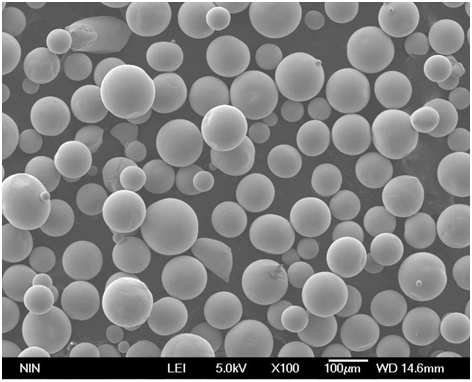
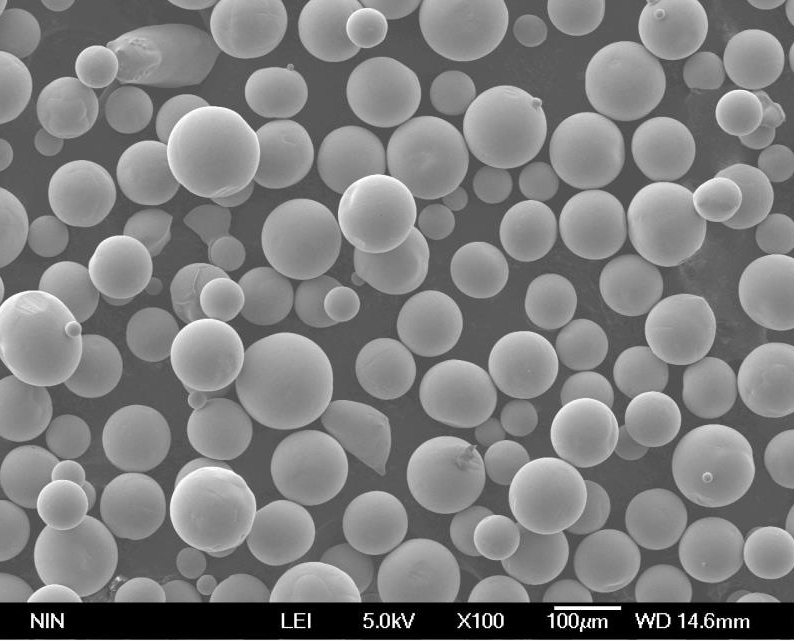
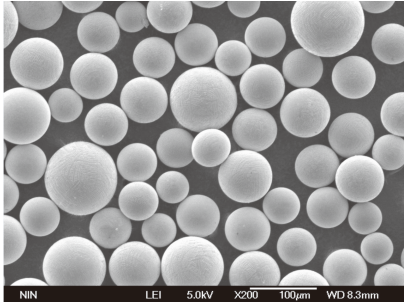
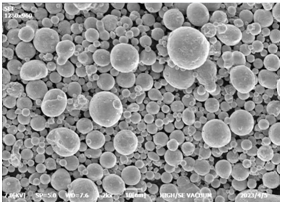

Applications de la poudre sphérique
Utilisations spécifiques à l'industrie
Les propriétés uniques de la poudre sphérique lui confèrent une valeur inestimable dans diverses industries. Voici comment différents secteurs tirent parti de ce matériau :
| L'industrie | application | Avantages de l'utilisation de la poudre sphérique |
|---|---|---|
| Aérospatiale | Aubes de turbines, composants de fusées | Rapport résistance/poids élevé, résistance à la chaleur |
| Automobile | Composants de moteurs, structures légères | Réduction du poids, amélioration du rendement énergétique |
| Médical | Implants, prothèses | Biocompatibilité, précision dans la fabrication additive |
| Électronique | Encres conductrices, composants | Conductivité électrique élevée, précision dans la microfabrication |
| Défense | Armures, munitions | Densité pour une protection balistique, qualité constante |
| L'énergie | Réacteurs nucléaires, panneaux solaires | Résistance aux températures élevées, efficacité dans la conversion de l'énergie |
Comment la poudre sphérique transforme la fabrication additive
La fabrication additive, ou impression 3D, est l'un des domaines les plus passionnants où la poudre sphérique a un impact significatif. L'uniformité et la fluidité de ces poudres sont parfaites pour créer des dessins complexes et des géométries complexes qui seraient impossibles à réaliser avec les méthodes de fabrication traditionnelles. Par exemple, dans la production d'implants médicaux personnalisés, la poudre de titane sphérique est utilisée pour créer des structures qui correspondent parfaitement à l'anatomie du patient, ce qui améliore les résultats et réduit les délais de guérison.
Comparaison de différents modèles de poudre sphérique
Comparaison détaillée de 10 modèles de poudres sphériques
Lorsque l'on choisit une poudre sphérique pour une application spécifique, il est essentiel de comparer les différents modèles en fonction de leurs propriétés, de leur composition et de leur coût. Le tableau ci-dessous compare dix modèles différents de poudre sphérique, en mettant en évidence leurs caractéristiques uniques et leurs utilisations idéales :
| Modèle | Matériau | Propriétés | Meilleur pour | Fourchette de prix (par kg) |
|---|---|---|---|---|
| ti-6al-4v | Alliage de titane | Haute résistance, biocompatible | Implants médicaux, aérospatiale | $350 – $450 |
| AlSi10Mg | Alliage d'aluminium | Léger, bonnes propriétés thermiques | Automobile, aérospatiale | $100 – $150 |
| 316L | acier inoxydable | Résistant à la corrosion, durable | Dispositifs médicaux, outils | $50 – $70 |
| CuNi2SiCr | Alliage de cuivre | Conductivité électrique élevée, résistance | Électronique, dissipateurs de chaleur | $200 – $300 |
| CoCrMo | Cobalt-Chrome-Molybdène | Biocompatible, résistant à l'usure | Implants dentaires, dispositifs orthopédiques | $400 – $500 |
| NiCr20TiAl | Alliage de nickel | Résistance aux températures élevées, solidité | Aérospatiale, énergie | $600 – $750 |
| Fe2O3 | Oxyde de fer | Propriétés magnétiques, abordables | Électronique, matériaux magnétiques | $20 – $40 |
| WNiFe | Tungstène-Nickel-Fer | Haute densité, protection contre les radiations | Défense, aérospatiale | $500 – $600 |
Spécifications et normes pour la poudre sphérique
Principales spécifications et normes pour la poudre sphérique
Lorsque l'on sélectionne Poudre sphérique pour diverses applications, il est essentiel de tenir compte des spécifications et des normes qui garantissent la qualité et les performances. En voici un aperçu détaillé :
| Spécifications | Description | Normes communes |
|---|---|---|
| Taille des particules | Diamètre des particules de poudre, généralement mesuré en micromètres (µm) | ASTM B330, ISO 3290 |
| Forme des particules | Sphéricité ou rondeur des particules | ASTM B212, ISO 19530 |
| Densité en vrac | Masse de la poudre par unité de volume | ASTM B329, ISO 3953 |
| Densité apparente | Densité de la poudre telle qu'elle apparaît en vrac | ASTM B212, ISO 3923 |
| La pureté | Pourcentage du matériau principal par rapport aux contaminants | ASTM E18, ISO 9001 |
| Capacité d'écoulement | La facilité avec laquelle la poudre s'écoule dans un entonnoir ou une goulotte | ASTM B213, ISO 4490 |
| composition chimique | Les éléments ou composés présents dans la poudre | ASTM E1621, ISO 6892 |
Tailles et qualités courantes des poudres sphériques
Différentes applications nécessitent des tailles et des qualités de poudre sphérique spécifiques. Voici un tableau présentant quelques tailles et qualités courantes :
| Taille (µm) | Grade | Utilisations typiques |
|---|---|---|
| 10 – 20 | Bien | Revêtements de précision, fabrication additive |
| 20 – 50 | Moyen | Composants automobiles, implants médicaux |
| 50 – 100 | Grossière | Applications industrielles, fabrication à grande échelle |
Fournisseurs et prix pour la poudre sphérique
Principaux fournisseurs et détails des prix
Voici un aperçu des principaux fournisseurs de poudre sphérique et de leurs prix :
| Fournisseur | Type de poudre | Fourchette de prix (par kg) | Site web |
|---|---|---|---|
| Ametek | Titane, aluminium | $300 – $500 | ametek.com |
| Sandvik | Acier inoxydable, Cobalt | $50 – $200 | home.sandvik |
| Höganäs | Fer, nickel, cuivre | $100 – $400 | hoganas.com |
| Groupe ARC | Tungstène, Zinc | $200 – $600 | arc-group.com |
| Élémentaire | Silicium, molybdène | $150 – $400 | elementum3d.com |
Facteurs de tarification
Le prix de la poudre sphérique peut varier en fonction de plusieurs facteurs :
- Type de matériau : Les matériaux de qualité supérieure tels que le titane et les alliages de cobalt et de chrome sont plus chers que les métaux standard tels que le fer ou l'aluminium.
- Taille des particules : Les poudres plus fines ont tendance à être plus coûteuses en raison du traitement supplémentaire nécessaire.
- La pureté : Les poudres de haute pureté sont généralement plus chères.
Comparaison des avantages et des inconvénients de la poudre sphérique
Avantages et limites de la poudre sphérique
Voici ce qu'il faut savoir sur les avantages et les inconvénients potentiels des poudres sphériques :
| Aspect | Avantages | Limites |
|---|---|---|
| Capacité d'écoulement | Un flux fluide et efficace pour la fabrication | Peut nécessiter des techniques de manipulation spécifiques |
| Densité d'emballage | Une densité plus élevée permet d'obtenir des matériaux plus résistants | Les poudres denses peuvent être plus difficiles à traiter |
| Finition de la surface | Finition de surface supérieure avec un post-traitement minimal | Coût plus élevé en raison des exigences de traitement |
| Uniformité | Qualité et performance constantes | La production d'une poudre sphérique uniforme peut être coûteuse |
| Coût | Économique pour la production en grande quantité | L'investissement initial dans des poudres de haute qualité peut être élevé |
Comparaison détaillée : Poudre sphérique et poudre irrégulière
- Poudre sphérique: Offre une fluidité et une densité de tassement supérieures. Idéal pour la fabrication de précision et les revêtements de haute qualité. Cependant, le traitement peut être plus coûteux.
- Poudre irrégulière : Généralement moins cher, mais peut entraîner un débit irrégulier et des problèmes d'étanchéité. Ils conviennent mieux aux applications où la précision est moins critique.
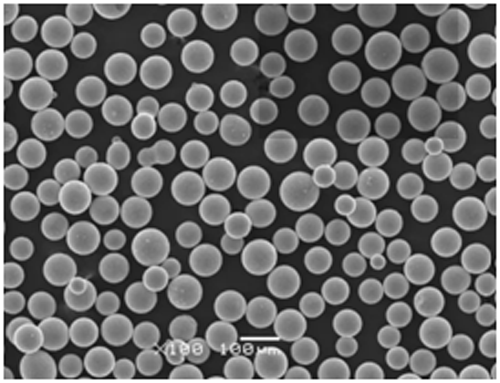
FAQ
| Question | Réponse |
|---|---|
| À quoi sert la poudre sphérique ? | La poudre sphérique est utilisée dans diverses applications, notamment la fabrication additive, les composants automobiles, les implants médicaux et l'électronique. Son uniformité garantit une qualité et une précision élevées dans ces domaines. |
| Comment la poudre sphérique est-elle fabriquée ? | La poudre sphérique est généralement produite à l'aide de techniques d'atomisation, où le métal fondu ou d'autres matériaux sont rapidement refroidis pour former des particules sphériques. D'autres méthodes incluent l'atomisation au gaz et l'atomisation à l'eau. |
| Quels sont les avantages de l'utilisation de poudre sphérique dans l'impression 3D ? | La poudre sphérique offre une excellente fluidité et une bonne densité d'empilement, ce qui permet de déposer des couches plus régulières et d'obtenir un produit final de meilleure qualité lors de l'impression 3D. |
| Comment la taille des particules affecte-t-elle les performances de la poudre sphérique ? | Les particules les plus fines offrent une meilleure résolution et une meilleure finition de surface, mais peuvent être plus difficiles à manipuler. Les particules plus grossières sont plus faciles à manipuler mais peuvent ne pas offrir le même niveau de détail et de finition. |
| La poudre sphérique peut-elle être recyclée ? | Oui, de nombreux types de poudres sphériques peuvent être recyclés, en particulier dans la fabrication additive. Toutefois, le processus de recyclage doit garantir que la poudre conserve sa qualité et ses caractéristiques. |
| Quel est le coût typique de la poudre sphérique ? | Le coût varie considérablement en fonction du matériau, de la taille des particules et de la pureté. Les prix peuvent aller de 20 dollars par kg pour les matériaux courants à plus de 750 dollars par kg pour les alliages spécialisés. |
| Où puis-je acheter de la poudre sphérique ? | La poudre sphérique peut être achetée auprès de fournisseurs spécialisés tels que Ametek, Sandvik, Höganäs, ARC Group et Elementum. Les prix et la disponibilité varient en fonction du type et des spécifications de la poudre. |
